In the lengthy first part of my Almanzo 100 race report, I dealt mostly with the overall shape of the experience for me. This second part relates some details that I want to remember, that fill out the Part I post, and that might be interesting to other cyclists who want to ride the Almanzo, other gravel events, or just gravel in general. (For much, much more of the same, see the collection of other riders’ Almanzo and Royal race reports…)
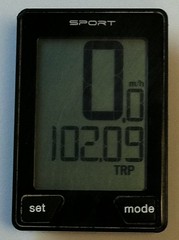
My Race
Reading those other race reports, I’ve been struck by the universal recollection of extreme hilliness – something like 6,800 feet of total climbing over the century course. I remember a lot of climbing (and descending), but the ups and downs were secondary, in my recollection, to the wind: a horrible headwind on the only substantial highway stretch, harsh crosswinds on many other sections, and once in a while a sweet tailwind. Wrong turns were another problem many others noted. Even though I did much of the race by myself, I didn’t take any wrong turns until sometime deep into the second half, a mile-long detour that was easily corrected.
The mud was just the mud: you had to deal with it. Everybody was trying to pick decent lines, and I was far enough back that I could usually find a good line simply by following tire marks in the mud. Sometimes, though, there were no good lines. Riding alone into a headwind, one discovers that it doesn’t much matter if you’re in the three-inch groove of watery goo, the two feet of packed-down mud flanking that groove, or the loose gravel everywhere else: you’re going to go slow everywhere. I think most riders had good enough technical skills to handle the mud. I didn’t see anyone stack it up, though I suppose it would be hard to tell someone who crashed into the mud apart from those of us who just rode in it. It was equal-opportunity filth.
I did lose heaps of time (and quite a few places) on the downhills. I consistently outclimbed most other riders – especially those on fully suspended mountain bikes, which were not the right rigs for the Almanzo – only to see many of those same riders pass and gap me on the downs. Between the greasy gravel, the unfamiliar roads, and my sense of needing to be cautious if I was going to finish, I just didn’t have the guts to really let my bike run on the descents. Like they say of Grand Tour riders, I descended like a father – not a bachelor. And it’s not as if the descents were really that hard. Though a couple had some S-curves to them, many were straight and many more had relatively gentle sweeps to them. I was just too chicken to really bomb them the way others did. And some of the downhills were nasty tricks: one descent went on and on and on, and then seemed to go on further still, but no! You had to hit the brakes, hang a hairpin left, and then head back up the same ridge you just descended. Lots of riders were cursing that climb.
Even so, I saw a lot of great stuff on the ride. Even driving down to Spring Valley on Saturday morning on US-52, I was happy to see many, many cars and trucks laden with gravel bikes. It was nice to be part of something big! When I was putting my bike together before the start, I was surprised by the number of mountain bikes – maybe a third of the field rode MTBs – and also by the number of people who were smoking, such as the captain of this tandem. Puff puff before huff and puff? Two other remembrances: passing a guy who was playing music from a boombox strapped to his bike, and seeing a racer kneeling on the shoulder of the road and holding the ends of his broken chain in a decidedly “why me, Lord?” way.
My Body
I was pretty pleased with how my body held up over the race. My training paid off: coming off a lot of skiing over the winter, I spent – between March 16 and May 13 – 46.5 hours on my bike (plus another dozen hours of running & strength work), accumulating a total of 866 miles. My longest single ride was a four hour, 60 mile ride at the end of April – far shorter than the Almanzo and yet I’d say good enough.
That time and those miles gave me very good legs to the halfway point, and – apart from the bonk I talked about in my first post – decent legs after that, too. Going into the race I was worried that my back would hurt, as it had on many of my (shorter, easier) training rides, but a better saddle helped a lot, and when I did start having a familiar burning soreness in my lower back, I managed to stretch it away with a minute of flexing on the bike. My only previous century – a for-the-hell-of-it ride last fall – was marred by severe knee pain after about mile 85, pain bad enough that I couldn’t stop because my knee wouldn’t work after any pauses. No such pain plagued me at Almanzo, thankfully. Again: training.
I was especially happy with my ability to climb, a capacity comprising both physical strength (let me note narcissistically here that I love what intense riding has done for my quadriceps!) and a good bike. Many riders walked many of the uphills, even some in the first 30 miles. I only walked one, and then only because I was having a nice talk with another rider and wanted to stick with him when he dismounted. I ended up going on alone when we got to the top of that hill anyhow, so it wasn’t worth the walk.
Though I can certainly improve my climbing (doing those mile-long ascents at 12mph, not 8mph; working on motoring up really long and/or steep hills when very tired, not just when fresh), the only real problems I had with my body were caused by problems with my brain. My Big Bong and Little Bonk were both caused, I see now, by losing focus and forgetting to take feeds that I’d scheduled. Lesson learned: miss a gel and suffer. (And the only post-race physical trauma was strange: bruises on the tips of my thumbs where my thumbnails had pressed the skin against my gloves!)
Looking toward Almanzo 2012, I would try to do an even thousand miles of training between the end of ski season and the race, and to complete at least one super-long ride – 8 hours, maybe 120 miles. That much more mileage, and that long ride, would prepare me adequately for another sufferfest “Hellmanzo” and give me excellent fitness for a “regular” race in decent conditions.
My Brain
Doing some mental training will benefit me for my next long gravel ride. Getting out past 80 miles or five hours and still concentrating on my feeding schedule will be key, both in training and then in another race.
On the plus side, I did manage to draw some strength from the slightly ridiculous sources that come to an overexerted body: singing various songs from Uncle Tupelo’s classic No Depression album (especially “Before I Break”), reading the words on my silly black HTFU wristband, and thinking a lot about the concept of sisu, which I mentioned in my first post.
I also need to work on whatever skills are needed to stick to riders who passed me. Though I think I still gained more places than I lost after the fifty-mile mark, quite a few riders passed me – often on downhills – and then hung out a consistent distance ahead of me. I couldn’t quite summon up the will to bridge up to them, even though I knew the companionship (and the windbreaking) would be helpful – and though I could tell we were traveling at the same speed! Another skill to develop in training…
My Bike
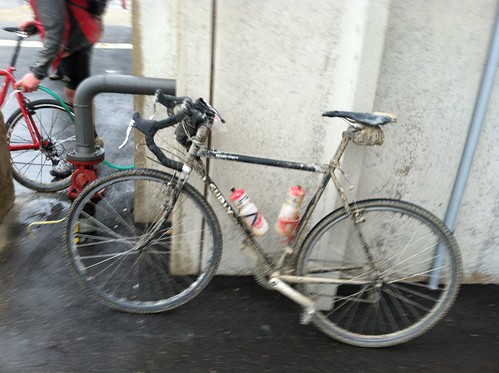
My Surly Cross Check performed great. I had no problems with it whatsoever: no mechanicals (not even the mud-and-grit drivetrain problems that others encountered), no punctures, no bad brakes. The Cross Check is simply a great gravel bike! Just before the race, I took my fenders off the bike and swapped out my winter tires for my summer rubber, 35mm Continental Speed Kings. The Speed Kings were fantastic. I don’t recall any slippage on any uphill, or any trouble getting good grip on the flats, whether they were mud, gravel, sand, or all three. And my new saddle was wonderful: very easy on the undercarriage, both fore and aft. Even if I had the chance to get a “better” bike – say, one of Salsa’s gravel bikes – I’m not sure I would. The Cross Check was that good. I will, however, see about getting a slightly lower bottom gear. My lowest gear handled the hills well, but I wonder if an even lower gear would have done still better.
Since the race was entirely self-supported – meaning, among other things, that no sag wagon was waiting to scoop up riders who couldn’t continue, whether for mechanical or physical reasons – I was equipped for most of the trouble a person can encounter on a bike ride. I brought two extra tubes, a compact pump and several CO2 cartridges, tire levers, a patch kit, and a multitool. Luckily, I didn’t have to use any of that stuff. (I don’t know how I would have changed a tire when my fingers were chilled enough that I couldn’t open a nutrition bar…)
Following many others’ gravel-race advice, I rode with one eye on my cyclocomputer, which performed perfectly even though it had seemingly gallons of water under the screen for most of the race. Does anybody make a cyclocomputer with a wiper blade to clean junk off the screen?
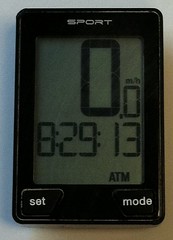
My Kit
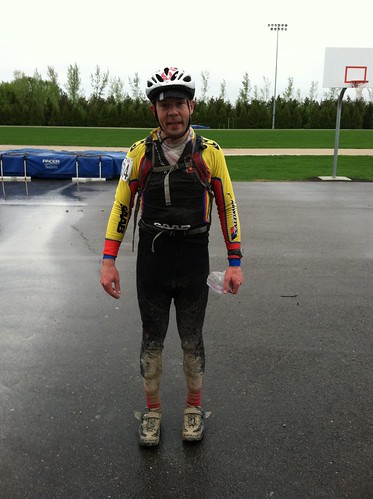
With two exceptions, my kit held up very well on the ride. Leading up to the race, I wasn’t sure if I should wear tights, knickers, or shorts on my legs or a long-sleeve or short-sleeve top. Once the forecast settled on a 40-degree day of rain and wind, I went with the knickers (already padded, but over a pair of padded cycle-short liners and, crucially, my Craft windbriefs) and the uninsulated long-sleeve top from a ski-racing suit. Under that top, I wore a midweight Craft thermal layer (maybe my favorite and best bit of workout clothing) and a sleeveless technical-fabric tee. The knickers and especially the skiing top were great: water repellent (to the extent they could be), breathable, and warm. On my feet, I wore a thin pair of cycling socks under my lightest pair of skiing socks. Though these – and my Shimano MTB shoes – were soaked for 95% of the race, they kept my feet warm. I put a cycling cap under my helmet, mostly for comfort. I wish I’d worn a skiing headband instead: I certainly did not need the cap’s brim for sun or water protection.
Against this, my eyewear was a total failure: my Rudy Project glasses were too dark for the gloomy conditions, and they gummed up immediately with mud and water. By mile 5, I’d already tucked them down my shirt, which meant I spent a lot of time wiping or blinking the water and road crud from my eyes. A pair of clear or yellow glasses would have been ideal – if I had been able to keep them clean.
I’d have to put my Garmin heart-rate monitor watch in a middle category, neither a success nor a failure.
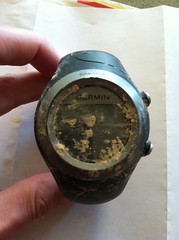
It held up fine during most of the race, reliably ticking off 30-minute intervals, but then died at about the two-thirds mark. It just doesn’t have enough battery power.
Even though my kit was better than “good enough,” I will still make a few improvements before my next gravel ride: a cue-card holder for my handlebars, a rain jacket, better full-finger cycling gloves (my old Performance gloves are just worn out), and a better pair of off-road cycling shoes. My entry-level Shimanos are comfortable and stay clipped in, but they’re also heavy and retain a lot of water owing to the fabric uppers. A new pair of shoes will be costly, but still about the price of a pair of running shoes, and far longer-lasting.
This looks like crazy fun…my next unaffordable gear purchase is going to be a ‘cross bike. Also, I have the next level up Shimano MTB shoes, and they’re great. When I was first looking, those ones you have turned me off with their bulkiness and fabric uppers. I ended up waiting to find a pair of ~$120 shoes on sale, and got them for about $90. If you’re in no rush to get new shoes, start trawling deal websites and local bike stores for sales.
Would waterproof or thermal booties have helped your feet? I’m always getting numb toes in the colder temps and wet conditions make it worse.
I wear a Timex Ironman 30-lap watch. I has a recurring timer that you can set for any interval. Members of my club are quite used to hearing it go off every 15 minutes, when they yell “DRINK!” Otherwise I tend to forget and will get behind on my hydration. Might be something to look into since your Garmin doesn’t have enough battery life. I wear separate HRM watch (bar mounted)